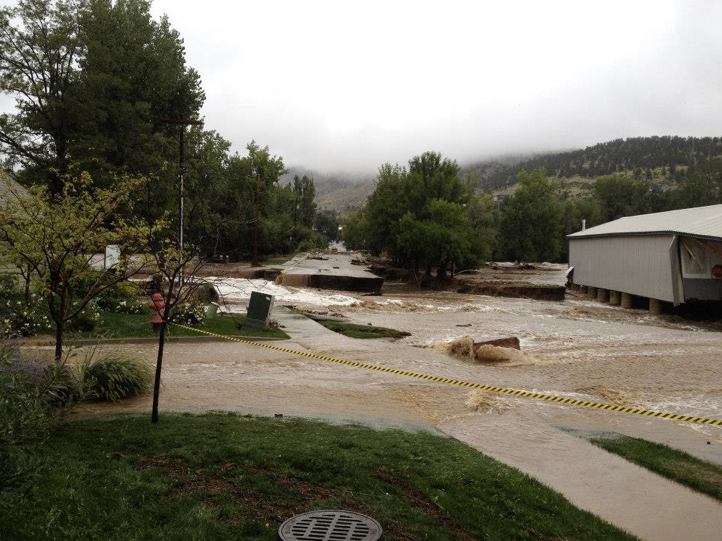Too Close to Home: Deluge Engulfs Flood Researcher's Town

DENVER — G. Robert Brakenridge has spent his career researching floods. But a lifetime's worth of knowledge didn't make it any easier when his own life was upended by rushing water.
Brakenridge, the director of the Dartmouth Flood Observatory and a senior scientist at the University of Colorado, Boulder, was among the hundreds of people cut off from the world in Lyons, Colo., in September, when days of heavy rain unleashed torrential floods along the Colorado foothills.
"You could hardly see the bridges anymore," Brakenridge told LiveScience. "They were almost invisible inside the river."
Lyons is a quiet, charming little town with a population of about 2,000. It sits on the banks of the St. Vrain Creek, a bubbling brook so shallow that you typically can't find a swimming hole near town, Brakenridge said. But a confluence of weather events that parked moisture over northern Colorado for days changed all that. Nearby Boulder, which also experienced severe flooding, received a record-breaking 9.08 inches (23.1 centimeters) of rain on Sept. 12.
Drainages like the St. Vrain channeled all that water into destructive torrents that swept away homes, bridges and roads. Lyons became a series of islands, cut off from electricity, water and rescuers. [See images of the flooded Colorado town]
A cut-off community
Brakenridge's flood story began in the wee hours of the morning on Sept. 12, when the Lyons flood alert system sent out an alarm. Brakenridge's neighborhood was dry, however, and the extent of the weather drama didn't become clear until people tried to head to work that morning, only to find that the bridges were underwater.
Get the world’s most fascinating discoveries delivered straight to your inbox.
From there, the Lyons residents were on their own. People began banding together, sharing food before it spoiled in warming refrigerators, and trading propane, flashlights and whatever else was needed, Brakenridge said. When a nearby irrigation ditch failed and began to flood the street, neighbors rushed out to build mud levees in an attempt to keep the water out of nearby homes.
"That part was just inspiring, to see that people really do pull together," he said. "You hear that they do. They do; they really do."
But confusion reigned, too. Rumors flew that an upstream reservoir dam might fail; some residents climbed the hill behind Brakenridge's home and pitched tents, preferring a wet night outdoors over the risk of being swept away in their homes.
The dam never failed, but the rumors did ultimately prompt a scramble to evacuate on Sept. 14, once the remaining bridge over the river was deemed safe. The Boulder County sheriff's department went door-to-door, asking residents to leave in a hurry.
By that time, Brakenridge and his wife had already packed up and left, having heard rumors a few hours earlier that the bridge leading out of the area was open. On the way out, as part of a convoy of cars headed to an evacuation center and then to points unknown, the couple got an unexpected lift: A sign by the side of the road, put up by a Good Samaritan, read, "Hang in there."
"That was just something to see that, that somebody would think to do that," Brakenridge said.
A flood's aftermath
Brakenridge and his team produced a regional map of the flooding, but their work is global: They've since moved on to monitoring other flood events around the world. On the grand scale of things, Brakenridge said, the Colorado flooding was minor. But the devastation of even a "minor" event has made Brakenridge more attuned to the suffering during major floods, he said.
"It was a compassion builder for me, for sure," he said. "I've been studying these [floods] all my life, and now I realize what it's really like."
Brakenridge and his wife are now staying in spare faculty housing at the University of Colorado in Boulder — incidentally, right next to Boulder Creek, which also flooded during the storm.
"That made us nervous the first few nights we were in this place," Brakenridge said.
Lyons remains unlivable. Town officials now say utilities may be restored by Thanksgiving. Many of the older homes in the town's downtown area were destroyed, and a popular park along the St. Vrain was wiped away.
"The river just tore the guts out of parts of the center of the town," Brakenridge said.
Follow Stephanie Pappas on Twitter and Google+. Follow us @livescience, Facebook & Google+. Original article on LiveScience.

Stephanie Pappas is a contributing writer for Live Science, covering topics ranging from geoscience to archaeology to the human brain and behavior. She was previously a senior writer for Live Science but is now a freelancer based in Denver, Colorado, and regularly contributes to Scientific American and The Monitor, the monthly magazine of the American Psychological Association. Stephanie received a bachelor's degree in psychology from the University of South Carolina and a graduate certificate in science communication from the University of California, Santa Cruz.


